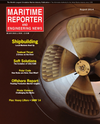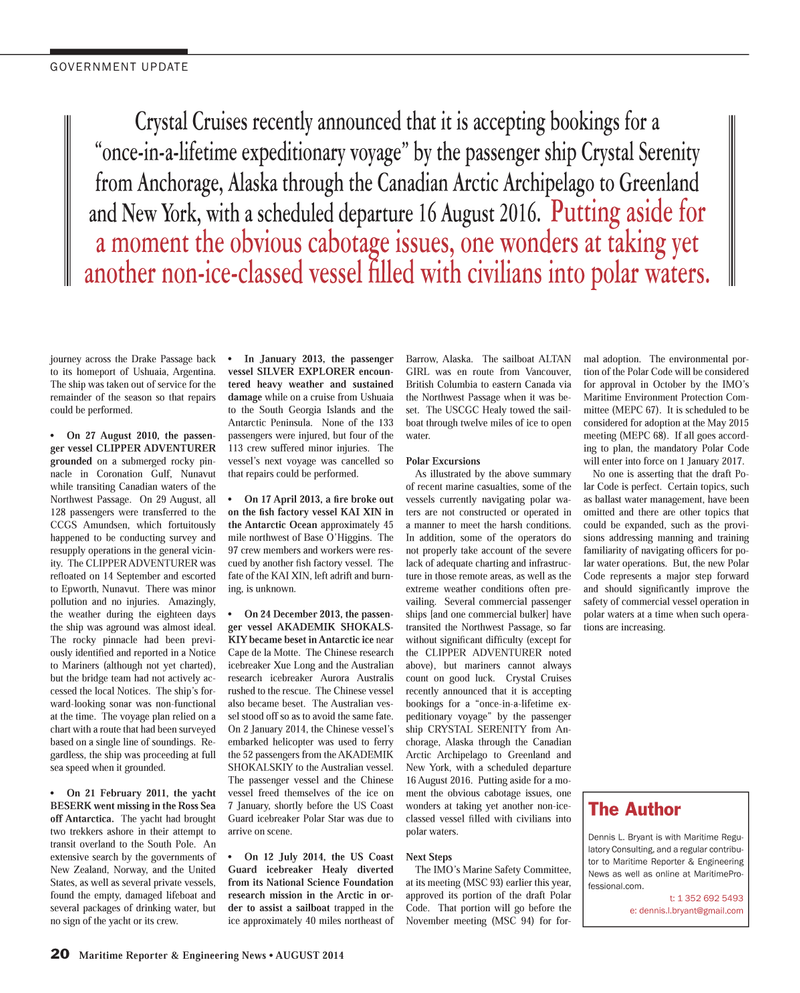
Page 20: of Maritime Reporter Magazine (August 2014)
Shipyard Edition
Read this page in Pdf, Flash or Html5 edition of August 2014 Maritime Reporter Magazine
20 Maritime Reporter & Engineering News ? AUGUST 2014 journey across the Drake Passage back to its homeport of Ushuaia, Argentina. The ship was taken out of service for the remainder of the season so that repairs could be performed. ? On 27 August 2010, the passen- ger vessel CLIPPER ADVENTURER grounded on a submerged rocky pin- nacle in Coronation Gulf, Nunavut while transiting Canadian waters of the Northwest Passage. On 29 August, all 128 passengers were transferred to the CCGS Amundsen, which fortuitously happened to be conducting survey and resupply operations in the general vicin-ity. The CLIPPER ADVENTURER was reß oated on 14 September and escorted to Epworth, Nunavut. There was minor pollution and no injuries. Amazingly, the weather during the eighteen days the ship was aground was almost ideal. The rocky pinnacle had been previ-ously identiÞ ed and reported in a Notice to Mariners (although not yet charted), but the bridge team had not actively ac-cessed the local Notices. The ship?s for- ward-looking sonar was non-functional at the time. The voyage plan relied on a chart with a route that had been surveyed based on a single line of soundings. Re-gardless, the ship was proceeding at full sea speed when it grounded. ? On 21 February 2011, the yacht BESERK went missing in the Ross Sea off Antarctica. The yacht had brought two trekkers ashore in their attempt to transit overland to the South Pole. An extensive search by the governments of New Zealand, Norway, and the United States, as well as several private vessels, found the empty, damaged lifeboat and several packages of drinking water, but no sign of the yacht or its crew. ? In January 2013, the passenger vessel SILVER EXPLORER encoun- tered heavy weather and sustained damage while on a cruise from Ushuaia to the South Georgia Islands and the Antarctic Peninsula. None of the 133 passengers were injured, but four of the 113 crew suffered minor injuries. The vessel?s next voyage was cancelled so that repairs could be performed. ? On 17 April 2013, a Þ re broke out on the Þ sh factory vessel KAI XIN in the Antarctic Ocean approximately 45 mile northwest of Base O?Higgins. The 97 crew members and workers were res-cued by another Þ sh factory vessel. The fate of the KAI XIN, left adrift and burn-ing, is unknown.? On 24 December 2013, the passen- ger vessel AKADEMIK SHOKALS- KIY became beset in Antarctic ice near Cape de la Motte. The Chinese research icebreaker Xue Long and the Australian research icebreaker Aurora Australis rushed to the rescue. The Chinese vessel also became beset. The Australian ves- sel stood off so as to avoid the same fate. On 2 January 2014, the Chinese vessel?s embarked helicopter was used to ferry the 52 passengers from the AKADEMIK SHOKALSKIY to the Australian vessel. The passenger vessel and the Chinese vessel freed themselves of the ice on 7 January, shortly before the US Coast Guard icebreaker Polar Star was due to arrive on scene. ? On 12 July 2014, the US Coast Guard icebreaker Healy diverted from its National Science Foundation research mission in the Arctic in or- der to assist a sailboat trapped in the ice approximately 40 miles northeast of Barrow, Alaska. The sailboat ALTAN GIRL was en route from Vancouver, British Columbia to eastern Canada via the Northwest Passage when it was be-set. The USCGC Healy towed the sail- boat through twelve miles of ice to open water. Polar Excursions As illustrated by the above summary of recent marine casualties, some of the vessels currently navigating polar wa-ters are not constructed or operated in a manner to meet the harsh conditions. In addition, some of the operators do not properly take account of the severe lack of adequate charting and infrastruc-ture in those remote areas, as well as the extreme weather conditions often pre-vailing. Several commercial passenger ships [and one commercial bulker] have transited the Northwest Passage, so far without signiÞ cant dif Þ culty (except for the CLIPPER ADVENTURER noted above), but mariners cannot always count on good luck. Crystal Cruises recently announced that it is accepting bookings for a ?once-in-a-lifetime ex-peditionary voyage? by the passenger ship CRYSTAL SERENITY from An- chorage, Alaska through the Canadian Arctic Archipelago to Greenland and New York, with a scheduled departure 16 August 2016. Putting aside for a mo- ment the obvious cabotage issues, one wonders at taking yet another non-ice-classed vessel Þ lled with civilians into polar waters.Next StepsThe IMO?s Marine Safety Committee, at its meeting (MSC 93) earlier this year, approved its portion of the draft Polar Code. That portion will go before the November meeting (MSC 94) for for- mal adoption. The environmental por- tion of the Polar Code will be considered for approval in October by the IMO?s Maritime Environment Protection Com-mittee (MEPC 67). It is scheduled to be considered for adoption at the May 2015 meeting (MEPC 68). If all goes accord-ing to plan, the mandatory Polar Code will enter into force on 1 January 2017. No one is asserting that the draft Po-lar Code is perfect. Certain topics, such as ballast water management, have been omitted and there are other topics that could be expanded, such as the provi-sions addressing manning and training familiarity of navigating ofÞ cers for po- lar water operations. But, the new Polar Code represents a major step forward and should signiÞ cantly improve the safety of commercial vessel operation in polar waters at a time when such opera-tions are increasing.GOVERNMENT UPDATE The AuthorDennis L. Bryant is with Maritime Regu- latory Consulting, and a regular contribu- tor to Maritime Reporter & Engineering News as well as online at MaritimePro- fessional.com. t: 1 352 692 5493 e: [email protected] Crystal Cruises recently announced that it is accepting bookings for a ?once-in-a-lifetime expeditionary voyage? by the passenger ship Crystal Serenity from Anchorage, Alaska through the Canadian Arctic Archipelago to Greenland and New York, with a scheduled departure 16 August 2016. Putting aside for a moment the obvious cabotage issues, one wonders at taking yet another non-ice-classed vessel lled with civilians into polar waters. MR #8 (18-25).indd 20MR #8 (18-25).indd 208/1/2014 11:15:42 AM8/1/2014 11:15:42 AM

 19
19

 21
21
